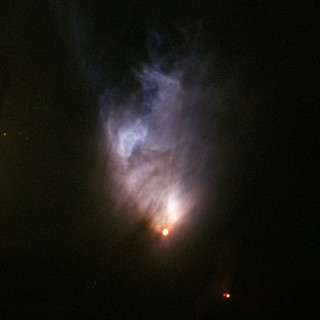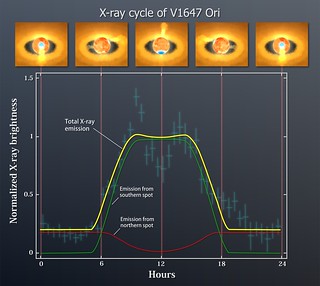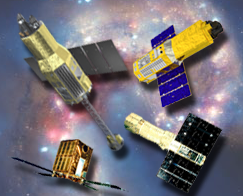In McNeil's Nebula, a Young Star Flaunts its X-ray Spots
Using combined data from a trio of orbiting X-ray telescopes, including NASA's Chandra X-ray Observatory and the Japan-led Suzaku satellite, astronomers have obtained a rare glimpse of the powerful phenomena that accompany a still-forming star. A new study based on these observations indicates that intense magnetic fields drive torrents of gas into the stellar surface, where they heat large areas to millions of degrees. X-rays emitted by these hot spots betray the newborn star's rapid rotation.
Credit: NASA's Goddard Space Flight Center
Astronomers first took notice of the young star, known as V1647 Orionis, in January 2004, near the peak of an outburst. The eruption had brightened the star so much that it illuminated a conical patch of dust now known as McNeil's Nebula. Both the star and the nebula are located about 1,300 light-years away in the constellation Orion.
Astronomers quickly determined that V1647 Ori was a protostar, a stellar infant still partly swaddled in its birth cloud. “Based on infrared studies, we suspect that this protostar is no more than a million years old, and probably much younger,” said Kenji Hamaguchi, an astrophysicist at NASA's Goddard Space Flight Center in Greenbelt, Md., and lead author of the study.
Protostars have not yet developed the energy-generating capabilities of a normal star such as the sun, which fuses hydrogen into helium in its core. For V1647 Ori, that stage lies millions of years in the future. Until then, the protostar shines from the heat energy released by the gas that continues to fall onto it, much of which originates in a rotating circumstellar disk.

Credit: Gemini Observatory
The mass of V1647 Ori is likely only about 80 percent of the sun's, but its low density bloats it to nearly five times the sun's size. Infrared measurements show that most of the star's surface has a temperature around 6,400 degrees Fahrenheit (3,500 C), or about a third cooler than the sun's.
Yet during the 2003 outburst, the protostar's X-ray brightness increased by 100 times and the temperature of its X-ray-emitting regions reached about 90 million F (50 million C). A new eruption began in 2008 and continues today.
During the outbursts, the brightness variations at optical and infrared wavelengths could be accounted for by changes in the protostar's main energy source, the inflow of matter onto the star. Because changes in X-ray brightness closely followed those in the optical and infrared, the higher-energy emission must also be linked to accretion.
“V1647 Ori gave us the first direct evidence that a protostar surges in X-ray activity as its rate of mass accretion rises,” said co-author Nicolas Grosso, an astrophysicist of the French National Center for Scientific Research (CNRS) at the Strasbourg Astronomical Observatory. This connection since has been underscored by a few other young stars whose outbursts included elevated X-rays.
To explore the emission process in detail and identify where on the star or disk the X-rays arise, the scientists re-analyzed all observations of V1647 Ori from three premier X-ray satellites — Chandra, Suzaku and the European Space Agency's XMM-Newton. Their goal was to find patterns that might provide clues to the sites of and mechanisms for producing the high-energy emission.
Writing in the July 20 issue of The Astrophysical Journal, the team reports that strong similarities among 11 separate X-ray light curves allowed them to identify cyclic X-ray variations. Remarkably, these periodic signals establish that the star is spinning once each day. V1647 Ori is among the youngest stars whose spin rates have been determined using an X-ray-based technique.
“Considering that V1647 Ori is about five times the size of the sun, the rapid spin confirms that we're watching a young stellar object that is in the process of pulling itself together,” said co-author Joel Kastner, a professor of imaging science and astronomical sciences and technology at the Rochester Institute of Technology in New York.
The cyclic X-ray changes represent the appearance and disappearance of hot regions on the star that rotate in and out of view. The model that best agrees with the observations, say the researchers, involves two hot spots of unequal brightness located on opposite sides of the star. Both spots are thought to be pancake-shaped areas about the size of the sun, but the more southerly spot is about five times brighter.
The hot spots represent the footprints of magnetically driven accretion flows from the disk to the surface of the young star. To reach the high temperatures associated with X-ray emission, matter must be hitting the protostar at a speed of about 4.5 million mph (2,000 km/s). As a result, the hot spots reach temperatures some 13,000 times hotter than anywhere else on the star.

Credit: NASA's Goddard Space Flight Center
“One attractive possibility for driving such high-speed matter involves magnetic fields that are undergoing a continual cycle of shearing and reconnection in mass accretion,” said David Weintraub, a professor of astronomy at Vanderbilt University in Nashville, Tenn., and a member of the study team.
Both the star and its circumstellar disk possess magnetic fields. Because the star rotates faster than the disk, these fields become twisted and sheared, storing up energy much like a wound-up rubber band. When the tangled field eventually rearranges into a more stable state, it suddenly unleashes its stored energy in a powerful blast. This process, called magnetic reconnection, also powers X-ray flares on the sun.
But while the physical processes may be similar, their time scales are vastly different. The peak X-ray output of a solar flare lasts less only minutes. The outbursts of V1647 Ori persist for years.
For comparison, consider the most powerful solar flare on record, the X28 eruption of Nov. 4, 2003. Hamaguchi calculates that the steady X-ray brightness of V1647 Ori's current outburst is a few thousand times stronger than the peak luminosity of the solar flare. What actually causes the star's outbursts? Astronomers don't really know. They suspect that gas from the outer portion of the disk makes its way inward, gradually building up the inner disk closer to the star. The strong magnetic activity may only turn on after some threshold is reached, but once it does the gas rapidly flows onto the hotspots and produces X-rays.
Thanks to Chandra, Suzaku and XMM-Newton, the outbursts of V1647 Ori are giving astronomers a glimpse of the extreme childhood of a sun-like star.



